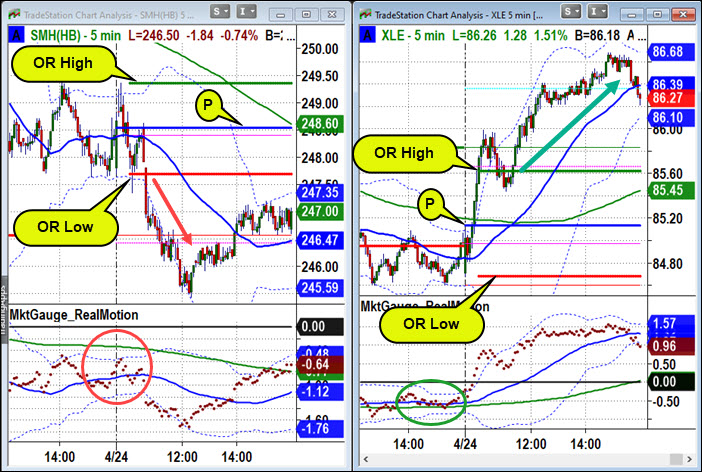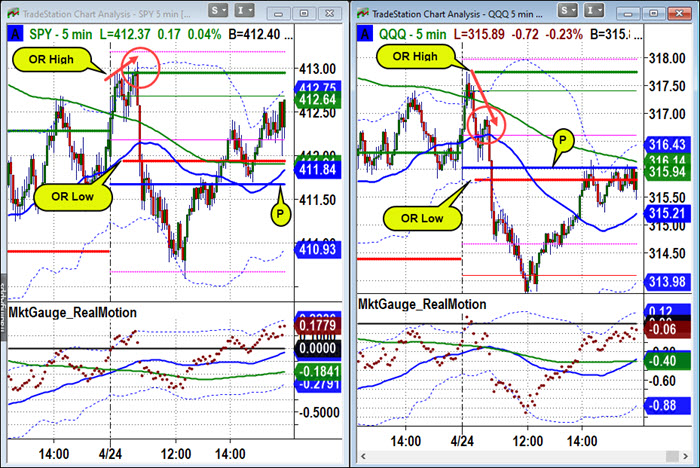Why Leaders Lost and Laggards Won Yesterday
2023.04.25 04:40
 Sector Performance Summary
Sector Performance Summary
There’s a simple professional trader’s tactic for anticipating intra-day market reversals near the levels that later become the high or the low of the day.
This tactic worked perfectly at calling today’s high of the day in SPDR® (NYSE:) (and the QQQ, IWM, and DIA).
This simple indicator works even better when the market’s sector rotation leads the move like it did today, so let’s start there.
Today’s image is our sector summary table that you can find for free in the “Big View” section of marketgauge.com. The table is ranked by 6 Month change (outlined in red) because we’ve found that time frame to be significant when gauging the persistence of trends.
As you can see, there was an interesting pattern of market rotation today (pointed out by the green arrows).
The pattern is simply that the leading sector (over the last 6 months), VanEck Semiconductor ETF (NASDAQ:), was today’s biggest loser on a percentage basis, while in contrast, the weakest sector, XLE (NYSE:), was today’s biggest winner.
In an otherwise quiet, choppy day, this sector rotation bookended the mood of traders who were focused on bespoke stock stories like earnings that didn’t translate into a general market trend.
If you read yesterday’s edition of this article, weakness in this leading sector shouldn’t come as a surprise.
If you’re also aware of our simple tactics for anticipating intra-day market reversals and trend days, then the trend days in both SMH and XLE should not come as a surprise, even though they were bucking their longer-term trends.
The simple tactic I’m referring to that enables you to anticipate daily highs and lows and trend days is the proper use of the Opening Range indicator.
The two-sentence tutorial for understanding the Opening Range is as follows…
The low and high of the first 30 minutes of the day will be significant support and resistance, and you should look for reversal patterns at these levels. If the market exhibits a confirmed breakout beyond the O.R. high or low, it is often a trend day.
With that in mind, look at the intra-day charts of SMH and XLE.
Notice in the SMH chart that when the price broke the OR low it trended lower.
In the XLE chart, when the price broke the OR high, it rallied, retraced to the OR high area, and then resumed its trend higher.

Now let’s look at the reversal at the high of the day in the SPY chart below.
Notice I’m showing you the Invesco QQQ Trust (NASDAQ:) chart too. The simple advanced Opening Range tactic for anticipating a market reversal is to look for divergences in the indexes at the Opening Range levels.
The red circles show an example of the SPY attempting to break over the OR high, while the QQQ demonstrates a significant negative divergence.
When you see a divergence like this, expect the SPY to reverse.

If you consider the two sets of charts together, you can see how the SHM started the day on a positive note, but never made an attempt to move over its OR high like the SPY, indicating that the market’s leader was not bullish today. This contributed to the weakness in the QQQ.
Intraday trading patterns aren’t just for day traders.
Today’s SMH chart is a good example of using the Opening Range to avoid buying into a weak day in the leading sector, but…
Of course if you’re reading this article daily, you know it’s not a good time to be buying SMH for other reasons.
ETF Summary
- S&P 500 (SPY) Tight range to watch this week 410-415 on a closing basis
- Russell 2000 (IWM) 170 support- 180 resistance
- Dow (DIA) Over the 23-month MA 336-support to hold
- Nasdaq (QQQ) 312 support over 320 better
- Regional banks (KRE) 44 now pivotal resistance
- Semiconductors (SMH) 258 resistance with support at 246
- Transportation (IYT) Still under the 23-month MA with 232 resistance 224 support
- Biotechnology (IBB) 130 major pivotal area-135 resistance
- Retail (XRT) 58- 64 trading range to break one way or another








